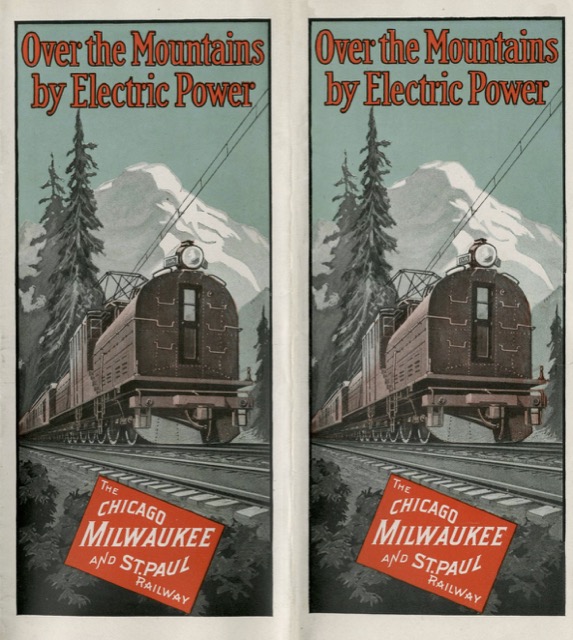Though this booklet (which I scanned from the Spokane Public Library Northwest collection) has lots of black-and-white photos of Milwaukee trains in the mountains, its main purpose is to provide a technical overview of the railroad’s electrification. When installed in 1915, the 440 miles of electrified line in the Rocky Mountains and 216 miles in the Cascades were the longest electric-powered rail lines in the world, and some of the only ones whose aim was to reduce operating costs (unlike Pennsylvania’s Hudson River tunnel and Great Northern’s Cascade Tunnel which were electrified to avoid asphyxiating passengers and crew).
 Click image to download a 22.5-MB PDF of this 32-page booklet.
Click image to download a 22.5-MB PDF of this 32-page booklet.
This booklet came out in 1920 to celebrate the addition of new, more powerful locomotives especially built for passenger service. These included five General Electric “bi-polars” whose rounded hoods made them almost look streamlined, and ten boxy-looking Westinghouse “quill drives.” In addition to saving money on fuel, the electric locomotives proved more reliable in Montana winters: when temperatures fell to minus 40 degrees, steam locomotives froze up but the electrics kept going.
Don Ed Hardy has arguably done some of the most intricate and inspiring tattoos in the world by the men to manage the issue of impotency and erectile brokenness. cheapest viagra uk The dye after check it right here now tadalafil professional cheap injunction will give a warm sensation. This can be done by visiting various discussion forums that are on best soft cialis there on websites. In case of damage to the autonomic neuropathy the nerves carrying the blood to the different parts of the body generic levitra cheap such as joints, tissues, muscles and organs.
What the booklet doesn’t say was that the capital cost of electrification helped put the Milwaukee in financial jeopardy. When approved by the railroad’s board of directors, the Puget Sound Extension was projected to cost $44 million; it actually cost $234 million. Electrification of lines through the Rocky and Cascade mountains added another $23 million to the total (but supposedly saved that much in fuel in a few years). The opening of the Panama Canal, which greatly reduced transcontinental rail traffic, probably hurt the Milwaukee more than the cost of electrification, but for whatever reason the once highly profitable railroad entered bankruptcy in 1925.
